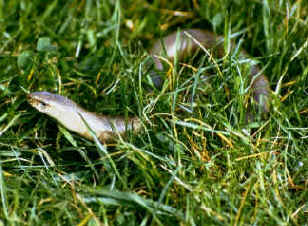
MEADOWS
Meadow Animals - continued

Amphibians and Reptiles Outside of the breeding season which is in early spring, wet meadows will harbour Common Frogs and Toads, feeding on the abundance of invertebrate life. Grass snakes may also be found, feeding on the frogs which are its main food. In drier meadows, Slow-worms (above) and Lizards, both mainly living in the boundary habitats around the meadow, may also hunt in the meadow itself. Slow-worms are slug-eaters while Common Lizards eat a variety of invertebrates, particularly spiders. Birds Few birds are exclusively associated with meadow habitats. Most are opportunists, perhaps more commonly associated with other habitats such as the hedgerows surrounding the meadows. They exploit the food value of the meadows at particular seasons. The seeds of the grasses and herbs in the meadow, which are allowed to mature before cutting, provide a rich resource at certain times of year, while the invertebrates in the meadow are a similar prize for insect-eating birds. Examples of such birds would include Goldfinches, feeding on thistle seeds and Starlings and Rooks searching the ground for leatherjackets.
The practice of early cutting of fields for silage and of cultivating right up to field margins means that any ground nesting birds in such fields do not have either enough time to safely rear their chicks, or enough invertebrate-rich areas to provide food for them. Were it not for game-bird shooting, it is likely that Grey Partridges would have followed the fate of the Corncrake, which is now virtually extinct in Britain. Grey Partridges are now only common on estates which are specifically managed for the benefit of game birds. Corncrakes similarly suffered from the loss of traditionally managed agricultural habitats such as hay meadows. Two Birds of Prey are particularly linked with meadows because of the high numbers of small mammals such as mice and voles, which they contain. These are the Kestrel and the Barn Owl. Kestrels may often be seen hovering above the grass verges of roadsides, which can be thought of as narrow strips of meadow, acting as a partial substitute for the real thing. Short-tailed, or field vole populations are high in meadows, where they create tunnelling runs through the grasses which are their food. They are diurnal, which means that they feed at any time of day. They mark their runs through the grass with urine trails. These trails reflect ultra-violet light which Kestrels are thought to be able to pick up, so locating their prey in the long grass.
Mammals
Small mammals such as long-tailed field mice (also known as wood mice), bank and field voles and shrews are common in meadows. Field mice are generalist seed and insect eaters, although in times of insect abundance they may switch their diets to take in more insects. Bank voles feed on herbs, leaves and seeds, while the field vole specializes in eating grasses. They particularly favour 'soft' grasses such as Agrostis and Festuca species, but also eat other grasses such as the Sweet Vernal-grass and Yorkshire Fog commonly found in meadows.
Larger mammals such as Roe Deer will graze in meadows, particularly when the first spring flushes of grass start to grow. Their dung further adds to the diversity of the meadow. The adult insects which emerge from the dung of grazing animals, having successfully completed their lifecycles within the dung, are important sources of food for bats. Greater Horseshoe Bats in particular, will hunt down the line of hedgerows and into the meadows after dung flies. Changes in modern farming practices mean that meadows are now a relatively rare habitat. It is clear from the previous discussions on the wildlife of meadows that their loss severely impacts upon a great diversity of plants and animals.
Continue to:- The Decline of Meadows |